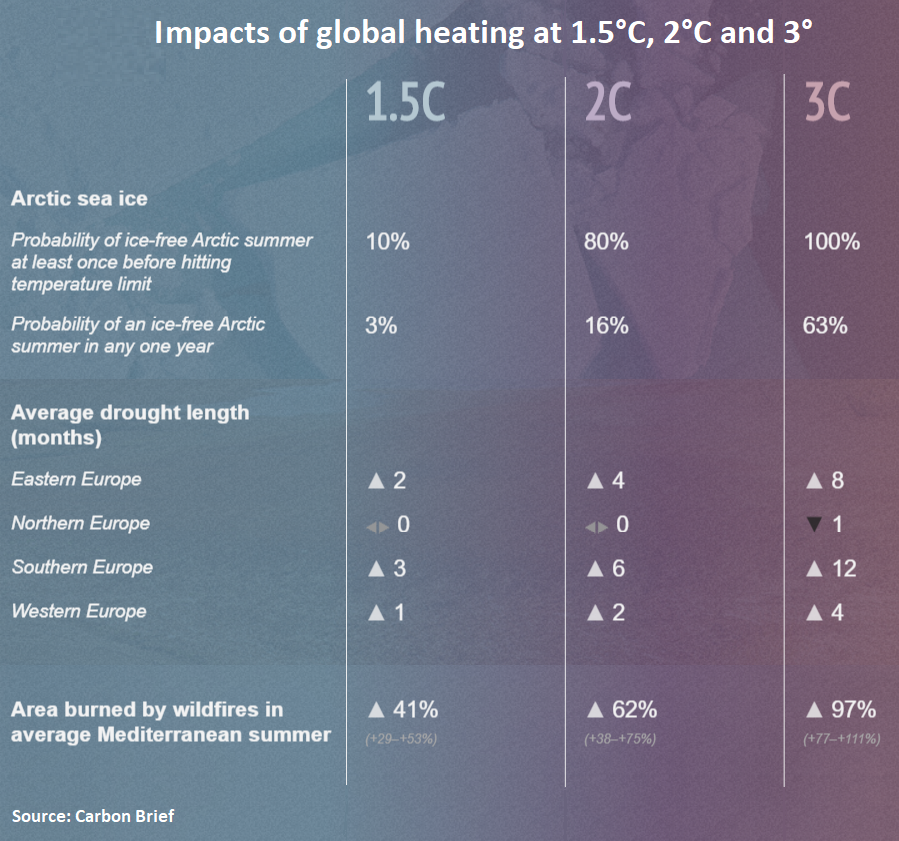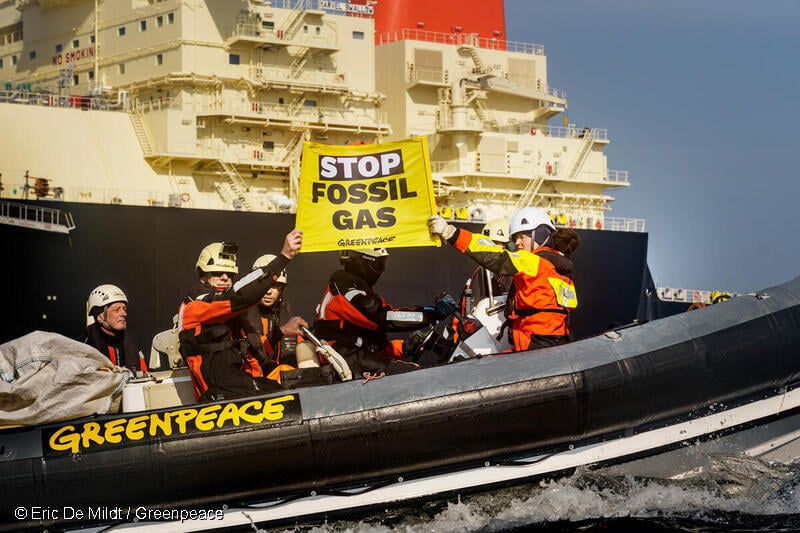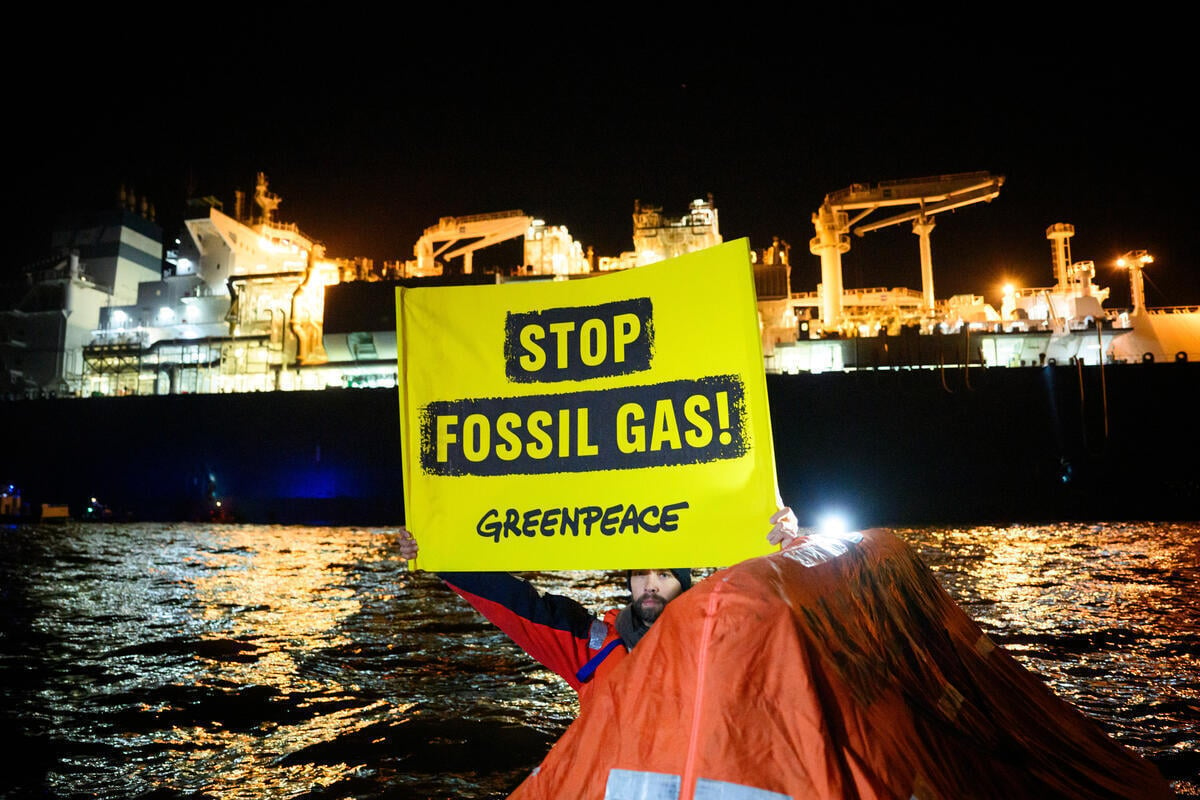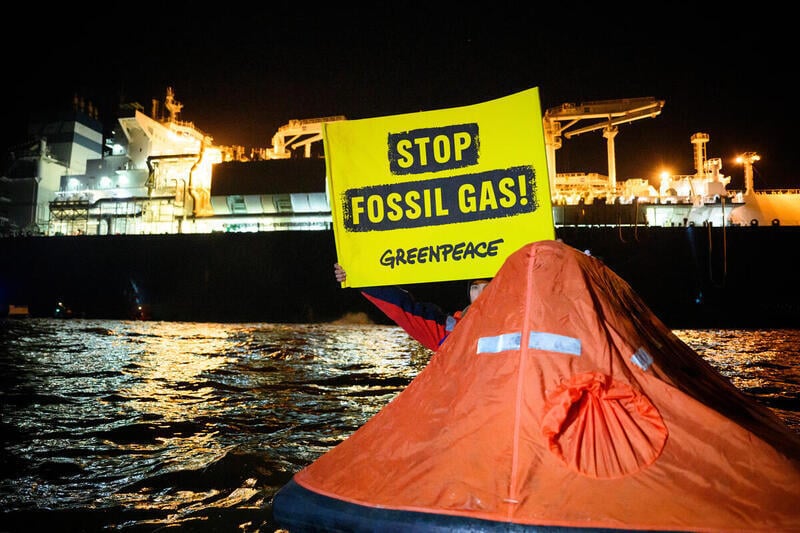As the climate emergency escalates and world leaders assemble for another global climate conference in Madrid in December, all eyes will be on Brussels. After a year of negotiations, government leaders will again attempt to agree a target to reduce EU emissions to net-zero by 2050. But they continue to put off urgent measures and an increase of the EU’s existing 2030 climate target in line with the Paris climate agreement. The new European Commission is scheduled to table a first draft of a European Green Deal on 11 December.
Sebastian Mang, Greenpeace EU climate policy adviser said: “Our house is on fire. People around the world are suffering and nature is collapsing. But instead of doing everything within their power to put out the blaze, our governments are dithering about. If the EU listens to UN scientists and takes action now to drastically cut emissions by 2030, we could prevent the most severe consequences for our planet.”
The global political response to the climate crisis has been woeful, including in Europe. Scientists estimate that current EU commitments to cut greenhouse gas emissions would lead up to 3°C of global heating and irreversible destruction from climate breakdown.
For the last year, EU governments have been discussing reducing emissions to net-zero by 2050. But a long-term climate target alone will not be sufficient. Failing to urgently cut emissions now – across sectors – and to raise the EU’s 2030 target would make extreme climate breakdown much more likely. “Had serious climate action begun in 2010, the cuts required per year to meet the projected emissions levels for […] 1.5°C would only have been […] 3.3 per cent per year on average. However, since this did not happen, the required cuts in emissions are now […] 7.6 per cent per year on average for the 1.5°C goal.”
The longer governments put off taking action, the more painful and expensive the transition to climate neutrality will be. Every delay puts us closer to tipping points that trigger an irreversible escalation of global heating.
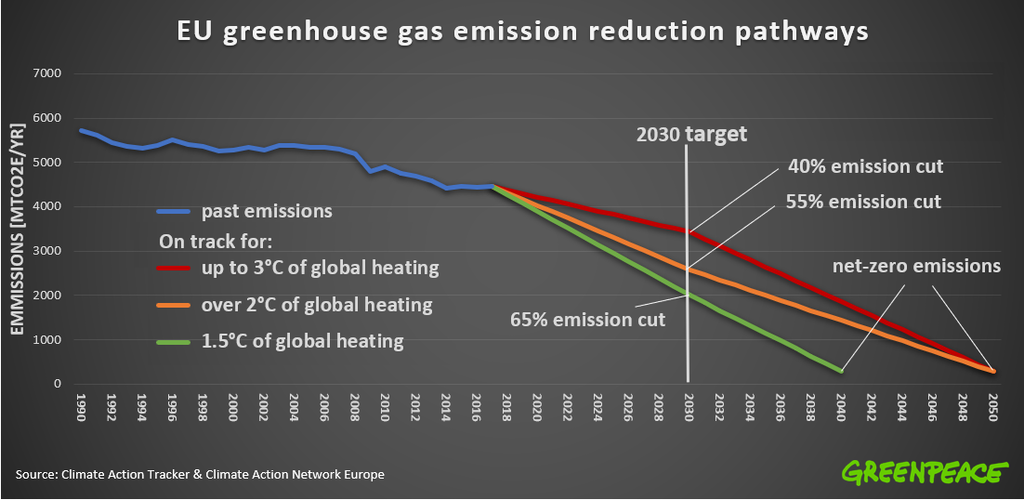
EU AS A GLOBAL PLAYER?
By next year, governments must submit new or updated climate pledges for 2030 under the Paris Agreement, which Greenpeace believes should be enhanced in line with the objective of restricting global heating to 1.5°C. This year’s COP25 climate conference in Madrid could already see some countries indicate that they are prepared to step up climate action. But as the US withdraws from the Paris agreement, the likes of China and India are unlikely to move unless the EU agrees to move on its 2030 target.
Although the vast majority of governments support the Commission’s proposed target of net-zero emissions by 2050, continued opposition from Poland, Hungary and the Czech Republic has so far prevented an agreement. Making funds available to ease the transition could facilitate a deal at the EU summit on 12 and 13 December.
The money could come in the form of a Just Transition Fund to support the communities and regions most affected by the transformation of their economies. The Commission is expected to propose the fund just ahead of the summit, on 11 December. The fund could be worth several billion euro, but the final details are still unclear. A crucial aspect for the climate-related success of the fund, will be whether access is conditional on national plans to phase out coal and gas.
With the impending 2020 Paris Agreement deadline, a growing coalition of European governments and politicians are pushing for an increase of the EU’s 2030 target. Failure by the Commission to propose a higher 2030 target in time for the March EU summit could mean a deal with governments cannot be reached in time.
UN secretary-general António Guterres, the European Parliament, incoming European
Commission President Ursula von der Leyen and several EU governments – France, Spain, the Netherlands, Portugal, Sweden, Luxembourg, Denmark, Latvia and Finland – have said the EU should increase its 2030 climate target to 55%. German chancellor Angela Merkel has indicated that she could support this, but her government has not adopted a formal position on the target.
Unfortunately, the 55% target would not be sufficient to limit global heating to 2°C, let alone to 1.5°C. To avoid a full-blown climate crisis, environmental groups are calling on the EU to cut greenhouse gas emissions by at least 65% by 2030 (compared to 1990 levels) and to achieve net-zero emissions by 2040.
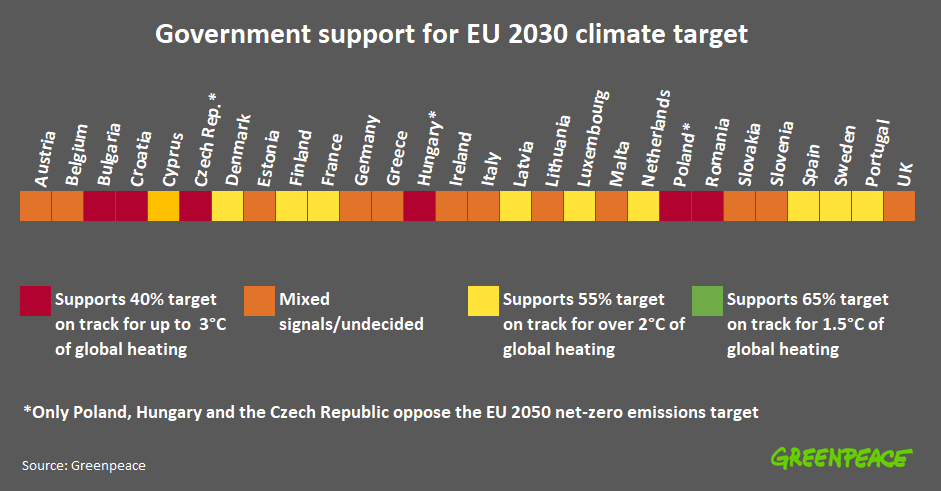
EUROPEAN GREEN DEAL
Incoming Commission president Ursula von der Leyen wants the EU’s 2030 target to be part of a wide-ranging European Green Deal. An outline of the green deal is likely to be released on 11 December (TBC), including a proposal for a Just Transition Fund, with the fully developed plans published in February or March.
The green deal is seen as a response to the rise of incontrovertible extreme weather and agricultural impacts of climate change and biodiversity collapse, harsh warning from scientists, increased public awareness and mobilisation and a new wave of political support for parties with strong environmental policies.
The Commission has promised a raft of different proposals. These include plans to increase the EU’s 2030 emissions reduction target from 40% to up to 55% and make the EU 2050 net-zero target legally binding (known as the EU climate law); a strategy meant to create sustainable food systems in Europe by 2030 (known as the Farm to Fork strategy); a strategy to respond to the destruction of nature and animal species by intensive agriculture, fishing, forestry and ocean exploitation (known as the EU biodiversity strategy); a strategy to eliminate waste and the exploitation of resources (known as the circular economy 2.0); and a strategy to stop water and air pollution, plastic pollution, and contamination from pesticides and other harmful substances (known as the zero pollution ambition).
How many of the measures put forward by the Commission will live up to their billing and have legal teeth is as yet unclear. Environmental groups, including Greenpeace, and youth climate strikers demand the Commission deliver concrete measures that achieve immediate cuts in greenhouse gas emissions, help restore nature and foster a fairer society. We argue that the companies and organisations most responsible for climate and ecological breakdown and that have benefited financially for decades be held responsible, bear the burden, and do not transfer costs to private individuals which would disadvantage poor and vulnerable people.
These emergency measures could include ending all new drilling for oil and gas and all fossil fuel subsidies, investing in public transport and rail networks for commuter and long-distance travel, banning allsingle-use plasticpackaging, stopping funding factory farms and instead rewarding farmers who respect nature and their animals, deploying Europe-wide support schemes to end energy poverty with large investments in home insulation and solar panels.
FINANCING THE TRANSITION
As part of the green deal, and to provide a financial plan for a transition to net-zero emissions, von der Leyen’s Commission is proposing a Sustainable Europe Investment Plan capable of mobilising up to one trillion euro in private funds over the next decade. This plan will come alongside the Just Transition Fund.
Environmental organisations have also called for the EU budget for 2021-2027 to facilitate this transition, for example, by ending funding for fossil fuels (most governments want to allow continued funding for gas), aviation and road infrastructure and industrial agriculture.
The European Economic and Social Committee has argued that the overall share of funds available for climate action under the EU budget should increase from the current 20% to 40%.
The Parliament and national governments are currently on opposite sides of the debate about whether to allow gas and nuclear investments to be rubber stamped as sustainable under a new set of rules (known as EU taxonomy rules). Just recently, the European Parliament voted in favour of the exclusion of all fossil fuels from EU regional development funds.
Not a single EU government has so far spelled out a comprehensive plan to phase out fossil fuel subsidies, despite a commitment taken at the G20 ten years ago to eliminate them by 2025. EU governments provided on average of €55 billion per year in fossil fuel subsidies between 2014 and 2016, according to research for Commission. Governments continue to subsidise fossil fuels through a variety of national and EU policies, including capacity mechanisms – a type of controversial subsidy given to coal, gas and nuclear plants, supposedly to ensure electricity supply in case extra power is needed.
In a positive move, a recent change in the lending policy of the European Investment Bank – the largest multilateral lender in the world – will severely limit funding for most new fossil fuel projects starting at the end of 2021. Despite loopholes that could allow continued funding for some gas projects, national governments, the European Central Bank and the global financial community are under pressure to follow suit.
BACKGROUND
Average world temperatures have already increased by over 1°C. From mega-hurricanes to monster fires, this has caused widespread devastation affecting millions of people. Europe too has started to feel the impact. The summer of 2019 saw major heat waves in western Europe, with temperature records and drought in several EU countries, including Germany, France, the Netherlands, Belgium, Sweden, and Luxembourg. In recent weeks, Italy, Poland, the Czech Republic and the United Kingdom have been struck by unprecedented floods.
In 2018, a landmark UN climate science report illustrated in stark terms the major differences in the impact of 2°C of global heating, compared to 1.5°C. The report by the Intergovernmental Panel on Climate Change warned that global emissions must be halved by 2030 (compared with 1990 levels), before falling to net zero as quickly as possible to limit global temperature rise to 1.5°C. Developed economies like the EU have the ability and the responsibility to go further. The EU has only agreed to cut emissions by 40% by 2030.
EU climate and environmental plans – a timeline
| WHEN | WHAT | WHAT TO LOOK OUT FOR |
| November 27 | Approval of von der Leyen European Commission | The Parliament is set to give the incoming von der Leyen Commission its seal of approval, allowing it to take office on 1 December. |
| November 28 | European Parliament resolutions: One on a climate and environmental emergency one on COP25 | The Parliament is expected to declare a climate and environmental emergency. The European Parliament is also expected to urge governments and the European Commission to agree an increase of the EU 2030 climate target to 55%, and support reaching net-zero emissions by 2050 at the latest. |
| 29 November | Global climate strike | School children and students are again expected to take to the streets in Europe and across the world on this ‘black Friday’. Demonstrators will protest against waste and consumerism and demand ramped up climate action by governments ahead of COP25. |
| 1 December | Von der Leyen Commission takes office | With a packed environmental agenda, the new Commission will have to hit the ground running to prove its green credentials. |
| 2-13 December | COP25 UN climate conference in Madrid | This climate conference is the last one before governments, including the EU, are expected to table their new or updated climate plans. As the US slowly withdraws from the Paris climate agreement, the EU will be under pressure to bring stronger targets to the table to encourage China, India and others to step up their climate pledges. |
| 4 December | European Environment Agency report on the state of the environment | From insect extinctions caused by pesticides, to air pollution from cars and coal plants, the report, which is published every five years, is expected to paint a dire picture of the state of the environment. |
| 5 December | Economic and financial affairs Council | Ministers will discuss a new set of rules for sustainable investments and green finance (known as EU taxonomy rules). The hot topic is whether gas and nuclear investments will get a ‘green’ stamp of approval. |
| 6 December | Climate protests around COP25 | Climate emergency protest march planned in Madrid and possibly Chile (the original host for COP25). |
| 11 December (TBC) | Commission communication on the European Green Deal and Just Transition Fund | The communication is expected to reveal the make-up of the green deal, including an EU climate law, and propose a range of financial instruments, including a Just Transition Fund for communities most affected by the transition to net-zero emissions. The fund is seen as a potential deal-clincher for an EU 2050 net-zero climate target. It could help soften opposition from Poland, Hungary and the Czech Republic, and allow discussions to start about upgrading the 2030 target. A crucial aspect for the climate-related success of the fund, will be whether access is conditional on national plans to phase out coal and gas. The green deal communication is also expected to announce strategies for environmental and climate action in farming (Farm to Fork strategy), plus a host of other measures, including a biodiversity strategy, a new circular economy strategy, and a zero-pollution strategy. The million-dollar question is whether the green deal includes real emergency measures to respond to the climate and ecological crises across the energy, transport, farming, commodities, and social sectors. |
| 12-13 December | EU summit | EU heads of government meet in Brussels as the COP25 climate conference enters its final two days. A deal on the EU’s 2050 net-zero target is on the cards. The EU is expected to review its 2030 target in 2020 under the terms of the Paris climate agreement. It is likely to be debated by EU leaders, but will not feature on the official summit agenda. |
| 16-17 December | Agriculture Council | European ministers are expected to comment on a Commission plan to tackle the EU’s responsibility in the destruction of the world’s forests, which fuels climate change and causes large-scale extinctions and environmental destruction. In particular, the Commission has pointed to the consumption of commodities like soy, palm oil, meat, cocoa and coffee. |
| 26-27 March 2020, 18-19 June and 15-16 October 2020 | EU summits | Discussions and possible deals on the 2030 climate target and EU budget. |
| September 2020 | EU-China summit | EU leaders and Chinese President Xi Jinping will discuss climate action at their meeting in Leipzig, Germany. |
| 9-19 November 2020 | COP26 UN climate conference in Glasgow | Deadline for the EU and all parties to the Paris climate agreement to submit updated climate commitments for 2030. |
Contacts:
Sebastian Mang – Greenpeace EU climate policy adviser: +32 (0)2 274 1905, [email protected]
Greenpeace EU press desk: +32 (0)2 274 1911, [email protected]
For breaking news and comment on EU affairs: @GreenpeaceEU
Greenpeace is an independent global campaigning organisation that acts to change attitudes and behaviour, to protect and conserve the environment and to promote peace. We do not accept donations from governments, the EU, businesses or political parties. We have over three million supporters, and offices in more than 55 countries.

